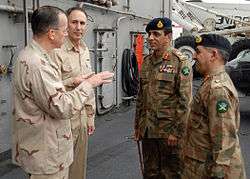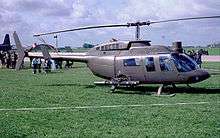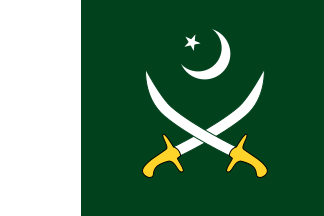Structure of the Pakistan Army
| ||||||||||||||||||||||||||||
The Structure of the Pakistan Army can be broken down two ways, administrative, and operational. Operationally the Pakistan Army is divided in 11 Corps having areas of responsibility (AOR) from mountainous regions of northern Pakistan to the desert and coastal regions of the south. Administratively it is divided in different regiments (details below). The General Headquarters (GHQ) of Pakistan Army is located in the garrison city of Rawalpindi in Punjab province. It is planned to be moved to the capital city of Islamabad.
Army headquarters and staff

The Chief of the Army Staff (COAS), formerly called the Commander in Chief (C in C), is challenged with the responsibility of commanding the Pakistani Army. The COAS operates from army headquarters in Rawalpindi, near Islamabad. The Principal Staff Officers (PSO's) assisting him in his duties at the Lieutenant General level include:
- Chief of General Staff (CGS) — Lt Gen
- Chief of Logistics Staff (CLS) — Lt Gen Ghayur Mahmood
- Inspector General Arms (IG Army) —
- Adjutant General (AG) — Lt Gen Anwar Ali Hyder
- Quarter-Master General (QMG) — Lt Gen Javed Mahmood Bukhari
- Inspector General Training and Evaluation (IGT&E) — Lt Gen
- Military Secretary (MS) — Lt Gen Shahid Baig Mirza
- Inspector General Communications and IT (IGC&IT) —
- Engineer-in-Chief (E-in-C) — Lt Gen Khalid Asghar
The Military Operations and Intelligence Directorates function under the Chief of General Staff (CGS). A major reorganization in GHQ was done in September 2008 under General Ashfaq Parvez Kayani, when two new PSO positions were introduced: the Inspector General Arms and the Inspector General Communications and IT, thus raising the number of PSO's to eight.[1]
The headquarters function also includes the Judge Advocate General (JAG), and the Comptroller of Civilian Personnel, the Chief of the Corps of Engineers (E-in-C) who is also head of Military Engineering Service (MES), all of them also report to the Chief of the Army Staff.
Operational structure
Hierarchy
- Corps: A Corps in the Pakistani Army usually consists of two or more Divisions and is commanded by a Lieutenant General. Currently the Pakistani Army has 11 Corps. The eleventh one is the recently raised Army Strategic Force Command (ASFC), responsible for bearing the national strategic and nuclear assets. Initially a Division, but then raised to the status of a Corps.
- Division: Each division is commanded by a Major General, and usually holds three Brigades including infantry, artillery, engineers and communications units in addition to logistics (supply and service) support to sustain independent action. Except for the Divisions operating in the mountains, all the Divisions have at least one armoured unit, some have even more depending upon their functionality. The most major of all ground force combat formations is the infantry division. Such a division would primarily hold three infantry brigades. There are 19 Infantry Divisions, 1 Special Operations Elite Combat Para Infantry Division (initially a brigade sized group but recently (January 2003) raised to a Division size group), two Mechanized Infantry divisions, two Armoured Divisions, 1 Engineers Division, 2 Artillery Divisions (which are widely believed to be in possession of Ballistics Nuclear Missiles - Therefore these Artillery Divisions are equivalent of Modern Ballistics Missile Artillery Division instead of traditional Artillery role usually associated with them) in the Pakistani Army.
- Brigade: A Brigade is under the command of a Brigadier and comprises three or more Battalions of different units depending on its functionality. An independent brigade would be one that primarily consists of an artillery unit, an infantry unit, an armour unit and logistics to support its actions. Such a brigade is not part of any division and is under direct command of a corps.
- Battalion: Each battalion is commanded by a Lieutenant Colonel and has roughly 600 to 900 soldiers under his command. This number varies depending on the functionality of the battalion. A battalion comprises either three batteries (in case of artillery and air defence regiments - generally named Papa, Quebec, Romeo, and Headquarters Battery) or four companies (in case of infantry regiments - generally named Alpha, Bravo, Charlie, and Delta - and other arms excluding armored units that are organized into squadrons) each under the command of a major and consisting of individual subunits called sections (which are further divisible into platoons and squads).[2]
Corps
There are 11 Corps located at various garrisons all over Pakistan.
| Corps | HQ Location | Major Formations under Corps | Commander | Notes |
|---|---|---|---|---|
| I Corps | Mangla, Azad Kashmir | 6th Armoured Division (Gujranwala), 17th Infantry Division (Kharian), 37th Infantry Division (Kharian) | Lt. Gen. Umar Farooq Durrani [3] | Formed 1958 in Abbottabad, now is in Mangla; Fought in the 1965 and 1971 wars, as well as sent replacements to Kashmir for LOC. |
| II Corps | Multan, Punjab | 1st Armoured Division (Pakistan) (Multan), 14th Infantry Division (Okara), 40th Infantry Division (Okara) | Lt. Gen. Ishfaq Nadeem Ahmad | Formed 1971 |
| IV Corps | Lahore, Punjab | 2nd Artillery Division (Pakistan) (Gujranwala), 10th Infantry Division (Lahore), 11th Infantry Division (Lahore) | Lt. Gen. Sadiq Ali [3] | Formed 1966 |
| V Corps | Karachi, Sindh | 16th Infantry Division (Pano Aqil), 18th Infantry Division (Hyderabad), 25th Mechanized Division (Malir) | Lt. Gen. Naveed Mukhtar | Formed 1975. 16, 18 IDs are all mechanized. Has a lot of independent Brigades as well, since it has all of Sindh to cover. |
| X Corps | Rawalpindi, Punjab | Force Command Gilgit-Baltistan (Gilgit), 12th Infantry Division (Murree), 19th Infantry Division (Mangla), 23rd Infantry Division (Jhelum) | Lt. Gen. Malik Zafar Iqbal | Raised in 1975 by Lt. Gen. Aftab Ahmad Khan |
| XI Corps | Peshawar, Khyber Pakhtunkhwa | 7th Infantry Division (Peshawar), 9th Infantry Division (Kohat) | Lt. Gen. Hidayat Ur Rehman | Formed 1975. Presently engaged in fighting in the Federally Administered Tribal Areas |
| XII Corps | Quetta, Balochistan | 33rd Infantry Division (Quetta), 41st Infantry Division (Quetta) | Lt. Gen. Aamer Riaz [3] | Formed 1985. |
| XXX Corps | Gujranwala, Punjab | 8th Infantry Division (Pakistan) (Sialkot), 15th Infantry Division (Pakistan) (Sialkot) | Lt. Gen. Ikram Ul Haq [3] | Formed 1987. Each division has 4 brigades and an armoured division is in the process of raising. |
| XXXI Corps | Bahawalpur, Punjab | 26th Mechanized Division (Bahawalpur), 35th Infantry Division (Bahawalpur) | Lt. Gen. Javed Iqbal Ramday | Formed 1988. |
| Army Air Defence Command | Rawalpindi, Punjab | 3rd Air Defence Division (Sargodha), 4th Air Defence Division (Malir) | Lt. Gen. Muhammad Zahid Latif Mirza | Formed 1990. |
| Army Strategic Forces Command | Rawalpindi, Punjab | 21st Artillery Division (Pano Aqil), 22nd Artillery Division (Sargodha) | Lt. Gen. Mian Muhammad Hilal Hussain[3] | Formed 2000. |
Armoured divisions
| Division | HQ Location | Brigades | Notes |
|---|---|---|---|
| 1 Armoured Division | HQ Multan | unknown | Part of II Corps |
| 6 Armoured Division | HQ Gujranwala | 7th Armoured Brigade, Kharian; 9th Armoured Brigade, Kharian; 1st Armoured Brigade, Kharian | Part of I Corps |
Infantry divisions
| Division | HQ Location | Brigades | Notes |
|---|---|---|---|
| 6 Infantry Division | N/A | N/A | Was the old Bahawalpur State forces, which joined the Pak Army on its formation. Disbanded after 1948 war. Today, 35th Infantry Division is located in Bahawalpur and carries the same Pelican insignia of the state forces, though there is no lineage. |
| Special Services Group (SSG) | HQ Tarbela | Known strength is 3 x Brigades (8 x Battalions); 2 x Independent Companies | Under Direct Joint Command of General Headquarters (Pakistan Army) (GHQ). A recently upgraded Division (in January 2003) with Maj. Gen. Ameer Faisal Alavi (Late) as its first GOC. It is the only special operations division (now) to have been raised step by step subsequently from a battalion size (19 Baloch Regiment) to a division directly under High Command in the history of modern military organizational development. The elements of the Group are engaged in a number of conflicts internally/externally, usually all the time, and are stationed under different Commands as required. Named Maroon Berets/Black Storks/Army SS Group. |
| 7 Infantry Division | HQ Peshawar | Y | XI Corps, Peshawar named as 'The Golden Arrows' |
| 8 Infantry Division | HQ Sialkot | Part of XXX Corps | |
| 9 Infantry Division | HQ Kohat | Part of XI Corps | |
| 10 Infantry Division | HQ Lahore | Part of IV Corps, stationed at Lahore, named as 'Tenacious Ten' | |
| 11 Infantry Division | HQ Lahore | 11 ID is part of IV Corps with HQ at Lahore. It is mechanised but seems to have less armored contingent then other mechanized formations. The division fought in 65 and 71 wars. The division is named as 'Battle axe' | |
| 12 Infantry Division | HQ Murree | Part of X Corps, 12th ID is a double sized division which has 7 infantry brigades. | |
| 14 Infantry Division | HQ Okara | Part of II Corps. The division is mechanised. | |
| 15 Infantry Division | HQ Sialkot | Part of XXX Corps | |
| 16 Infantry Division | HQ Pano Aqil | Originally was part of XII corps, shifted at Panno Aquil Cantonment in 1987. Now form part of V Corps [4] | |
| 17 Infantry Division | HQ Kharian | Part of I Corps | |
| 18 Infantry Division | HQ Hyderabad | Part of V Corps | |
| 19 Infantry Division | HQ Mangla | Part of X Corps | |
| 23 Infantry Division | HQ Jhelum | 3 (AK) Brigade (Kotli); 4 (AK) Brigade, 66 Brigade, 333 Brigade | Part of X Corps |
| 25 Mechanized Division | HQ Malir | Part of V Corps | |
| 26 Mechanized Division | HQ Bahawalpur | Part of XXXI Corps | |
| 33 Infantry Division | HQ Quetta | 29 Infantry Brigade (Zhob);60 Infantry Brigade (Sibi);205 Infantry Brigade (Loralai);Divisional Artillery(Zhob)[4] | Part of XII Corps |
| 35 Infantry Division | HQ Bahawalpur | Part of XXXI Corps | |
| 36 Infantry Division | N/A | N/A | Disbanded after 1971 war |
| 37 Infantry Division | HQ Kharian | Part of I Corps | |
| 39 Infantry Division | N/A | N/A | Disbanded after 1971 war; see below |
| 40 Infantry Division | HQ Okara | Part of II Corps | |
| 41 Infantry Division | HQ Quetta | Part of XII Corps |
Air Defence Divisions
| Division | HQ Location | Brigades | Notes |
|---|---|---|---|
| 4 AD Division | HQ Malir | AD Brigade, Malir; AD Brigade, Quetta | Part of Army Air Defence Command |
| 3 AD Division | HQ Sargodha | 3 AD Brigade, Sargodha; 4 AD Brigade, Lahore | Part of Army Air Defence Command |
Artillery Divisions (Modern Ballistics Missile Artillery Division)
| Division | HQ Location | Brigades | Notes |
|---|---|---|---|
| 21 Artillery Division | HQ Pano Aqil | Classified | under Army Strategic Forces Command (Pakistan) |
| 22 Artillery Division | HQ Sargodha | Classified | under Army Strategic Forces Command (Pakistan) |
Independent brigades
There are seven Independent Mechanized Infantry Brigades, eight Independent Armoured brigades, 4 Artillery Brigades, and nine Engineer brigades. These include 105 Independent Brigade Group in XXXI Corps, 111 Independent Infantry Brigade at Rawalpindi with X Corps, 212 Infantry Brigade at Lahore with IV Corps and 105 Independent Infantry Brigade under V Corps. Nine independent signal brigade groups are also present (one in each corps).
Former formations
Eastern Command was a Corps level formation in the former East Pakistan consisting of 14th, 9th and 16th Infantry Divisions. All three were re-raised after the war and exist today.
36 ID and 39 ID were raised to command the Paramilitary troops and a few loyal battalions. Were later reinforced with a couple of other battalions each. They were not re-raised after the war.
Administrative structure
The Pakistani Army is divided into two main branches, which are Arms and Services.
Infantry, Armour, Artillery and Army Air Defence
The Army's infantry force includes two Special forces Brigades with 5 Battalions, The Pakistan Armoured Corps includes eight Armoured Reconnaissance regiments, while the Air Defence also includes three Strategic Defence and 12 Self Propelled (SP) Regiments
|
|
|
|
*The President's Bodyguard formed at independence from members of the Governor General's Bodyguard, itself successor to the Governor's Troop of Moghals raised in 1773
*5th Horse is the successor to the 1st Sikh Irregular Cavalry (Wales's Horse), and the 2nd Sikh Irregular Cavalry, both raised in 1857
*6th Lancers is the successor to The Rohilkhand Horse raised in 1857, and the 4th Sikh Irregular Cavalry raised in 1858
*Guides Cavalry (Frontier Force) is the successor to the Corps of Guides raised in 1846
*11th Cavalry (Frontier Force) is the successor to 1st Regiment of Punjab Cavalry and 3rd Regiment of Punjab Cavalry, both raised in 1849
*13th Lancers is the successor to the 1st Native Troop raised in 1804, and the 2nd Native Troop raised in 1816. It is also the senior most armour regiment of the Indian Sub-Continent.
*19th Lancers is the successor to the 2nd Mahratta Horse (Tiwana Horse) raised in 1858, and Fane's Horse raised in 1860
*25th Cavalry (Frontier Force) is the famous unit which stopped Indian armour thrust in Chawinda in 1965
*29th Cavalry Regiment, nicknamed as 'Royal Bengal Tigers' was the armored regiment stationed in former East Pakistan. Entire regiment was lost in 1971 war and was raised later with nickname 'Tigers'. Currently the regiment forms part of 6th Armored Division and is stationed at Kharian.
*6 Light Air Defence (Glorious) is the famous unit which downed more than 36 IAF Fighter Jets during Battle of Dhaka in 1971, it was the 1st ever Anti Aircraft Regiment of the United India raised in 1912
*5 Light Air Defence (Fakhar e Quaid) was the first ever Army unit to be inspected by Quaid e Azam Muhammad Ali Jinnah Founder of the Nation in 1948, this unit can be traced back to 125th Royal Heavy Anti Aircraft Artillery Raised at Woolwich England in 1918
*19 SP Air Defence was the 1st Self Propelled Air Defence Unit attached to Armored Formation
*153 SP Air Defence (Fakhar e Tabuk) raised in 1990 took active part in Operation Desert Storm in 1991 over Saudi Iraqi Border and Intercepted Number of Iraqi Scud Surface to Surface Missiles
*The Punjab Regiment formed in 1956 from the 1st, 14th, 15th and 16th Punjab Regiments; can be traced back to the 3rd Battalion of Coast Sepoys raised in 1759
*The Baloch Regiment formed in 1956 from the 8th Punjab Regiment, The Baloch Regiment, and The Bahawalpur Regiment; can be traced back to the 3rd Extra Madras Battalion raised in 1798
*The Frontier Force Regiment is the successor to the Frontier Brigade raised in 1846
*The Azad Kashmir Regiment was raised in 1947, became part of the army in 1971
*The Sindh Regiment was raised in 1980 from battalions of the Punjab Regiment and Baloch Regiment
*The Northern Light Infantry was formed in 1977 from various paramilitary units of scouts, became part of the army in 1999 after the Kargil War
*The Special Service Group was formed in 1959 around a cadre from the Baloch Regiment
Fighting Arms


- Infantry
- Armoured Corps
Supporting Arms
- Corps of Artillery
- Corps of Engineers
- Corps of Signals
- Army Air Defence
- Army Aviation (23 squadrons)
Services
- Ordnance
- Corps of Electrical & Mechanical Engineers (EME)
- Army Service Corps (ASC)
- Army Education Corps (AEC)
- Corps of Military Police (CMP)
- Corps of Military Intelligence (CMI)
- Army Clerical Corps (A.C.C)
- Remount, Veterinary, and Farms Corps (RV&FC)
- Army Medical Corps (AMC)
- Army Dental Corps (ADC)
- Armed Forces Nursing Services(AFNS)
References
- ↑ Iftikhar A. Khan. "Kayani shakes up army command" Dawn, 30 September 2008
- ↑ "Subdivisions of the army". Retrieved 2007-01-21.
- 1 2 3 4 5 Express Tribune. "Major reshuffle: Four army major generals promoted to next rank". Express Tribune. The Express Tribune, September 23rd, 2015. Retrieved 18 December 2015.
- 1 2 http://horsesandswords.blogspot.com/2006/03/administrative-control-over.html - Note 10
